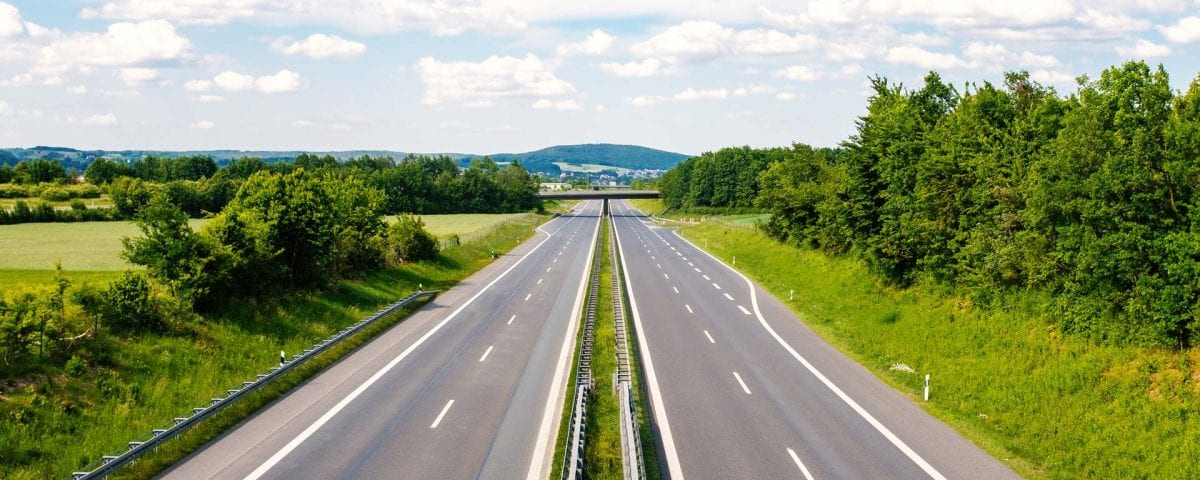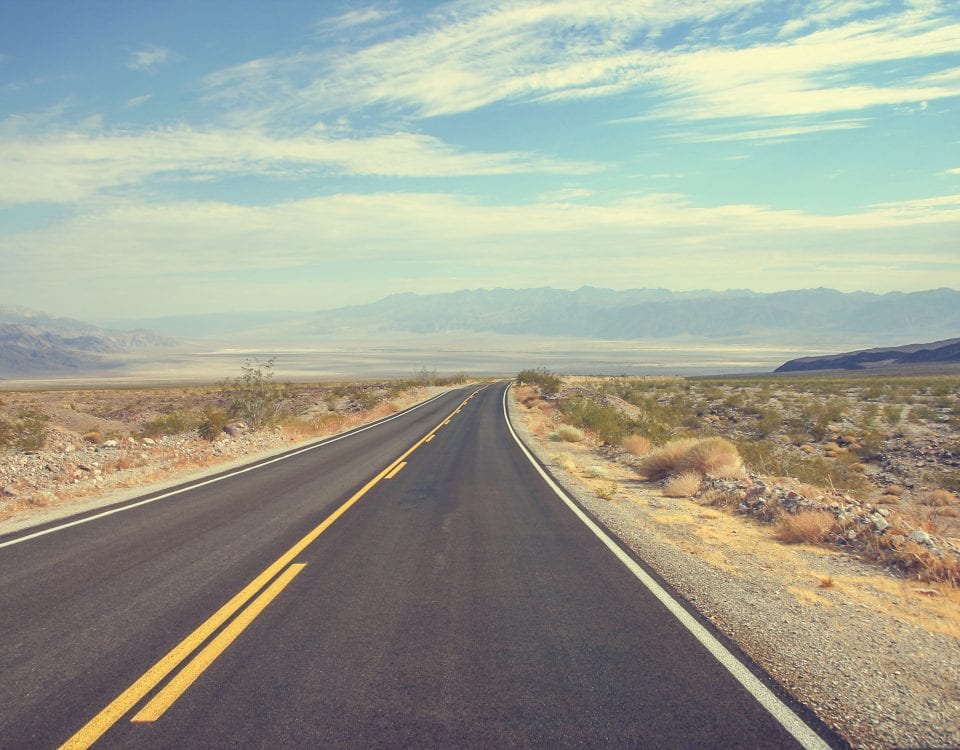
Some Interesting Facts About the States
June 22, 2020
Famous People From Not So Famous Places
February 3, 2021Sometimes big plans start with one simple thought.
A reunion of friends can begin with a short text message.
A home remodeling project can germinate from one crack on a wall.
An exercise routine can evolve from a single inspirational message.
That’s how this 60-day journey across the United States came to fruition.
On a lazy afternoon in August 2018, I was thinking about when I might retire. I mused on the possibility of November 2020, the month of my 66th birthday. At that time, I could start collecting Social Security benefits and also keep earning money by freelance writing or other means without any reductions in my monthly SSI payments.
Turns out I didn’t retire that month. But the thought got me pondering.
I’ve always wanted to drive across the country. An out-and-back from California along two different routes. That sounded like an enticing expedition. And I didn’t need to wait until I retired. I could embark on the trip the year after my 66th birthday using stored-up vacation time.
It didn’t take long for that simple thought to blossom into a plan to establish a web page and write about my travels. This called for more than touching one coast and returning to the other.
——————
This bubbling idea quickly morphed into a 40-day trip that skirted the coastlines but also cut across the middle of the country.
The ideal time to start seemed to be mid-March 2021. The weather would likely be tolerable and Daylight Saving Time would have already passed.
The first day of spring turned out to be Saturday, March 20. A 40-day journey would bring me home in late April. A perfect beginning and endpoint.
It made sense to travel through the Southwest and the South first since the weather in late March would be less risky there. Then, a jaunt through the Northeast before knifing through the Midwest, sailing through Big Sky country and the Northwest before gliding home.
A path through 43 states was laid out. It seemed fine, but since we were so close to all 48 states in the continental United States, why not go for it?
A new route was graphed with all the contiguous states. I decided early on to skip major cities in the American lexicon such as New York, Chicago, Boston, and Los Angeles. Most people have visited those metropolises and are quite familiar with them. The only exception was Philadelphia due to its historical significance as well as its many interesting facets, including Boathouse Row, its outdoor murals, and, of course, its cheesesteak sandwiches.
Even with that, it didn’t take long to realize that 48 states in 40 days was too rushed.
We were cutting a lot of corners. The only stops in Colorado and Utah were at the Four Corners Monument where those states meld with Arizona and New Mexico. The only time spent in Florida would be speeding through Pensacola on the Panhandle.
Plus, there were a lot of 7-hour and 8-hour driving days, not allowing much time to stop and absorb the importance of some of our most historic as well as interesting places.
———————
A 50-day map was tediously drawn up.
The original plan to travel from Houston to New Orleans was scrapped in favor of a route that headed north from San Antonio to include Oklahoma and then east to Arkansas before zooming southward through Louisiana.
Florida was expanded to include Tallahassee, Jacksonville, and St. Augustine, the oldest European settlement in the United States.
Two-night stays were added in Albuquerque, New Orleans, Philadelphia, St. Louis, and West Yellowstone.
Research into all the towns along the way turned up a lot of gold.
There’s the small Vermont town where the first paintball game was played.
The New Mexico community contaminated by the first atomic bomb tests.
Did you know Waco, Texas, has a Dr Pepper museum? Do you know why?
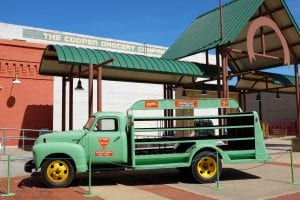
An antique delivery truck at the Dr Pepper Museum in Waco, Texas
A small town in Virginia contains the National D-Day Monument. There’s a reason it’s there.
An unsightly auto repair yard in western Maryland that prompted the nation’s Highway Beautification Act is still in business.
The spot where General George Washington crossed the Delaware River not once but twice isn’t too far from Philadelphia.
Walden Pond in Massachusetts is actually pretty large lake enjoyed by tens of thousands of people every year.
Ever hear of the Great Black Swamp along the Indiana/Ohio border?
A news report on the death of the woman who was the inspiration for Buddy Holly’s “Peggy Sue” brought me to Clear Lake, Iowa, where the singer’s plane crashed.
The closure and reopening of factories forced other communities onto the route.
That November, my daughter, Melinda, and her husband, T.J., presented me on my birthday with a book about 1,000 “off the beaten path” places in the United States. That swelled the number of stops on the itinerary.
To make time for all these places, the two-day visits to Albuquerque, St. Louis, and New Orleans were shortened to one day each. Still, there were a multitude of 7-hour and 8-hour driving days.
There was only one solution.
————————-
In December, the journey across America was lengthened to 60 days. It still started on March 20 but now ended on May 18, a few days before my wife Mary’s birthday.
The itinerary couldn’t be stretched any further. Sixty days would have to work, one way or another.
The two-month timeline allowed me to add St. Louis and New Orleans back as two-day stops, giving me driving breaks at two weeks, four weeks, six weeks, and eight weeks.
Other places that had fallen off the agenda returned. Cincinnati was on the 40-day roster, taken off on the 50-day plan and reinstated on the 60-day list.
However, further research would start to chip away at the two-month plan, prompting revisions and replacements.
I started reading the book, “Our Towns,” written by James and Deborah Fallows about flying their small plane to various locales across the country that are making comebacks. That added a couple more stops.
News items kept redrawing the map. A report on the air pollution in the manufacturing city of Clairton near Pittsburgh caused a recalibration of western Pennsylvania.
The more I read, the more my route changed. But that was OK. This journey, I decided, should remain fluid. Not set in stone.
—————————-
In January 2019, the middle 20 days of the journey suddenly didn’t look right.
The route carried me from the South to a piece of the Midwest to a slice of the Rust Belt before entering the Northeast. I was passing through those areas a second time on my way back.
I decided to conquer one region at a time.
So, a path was sketched that traveled from the Southwest to the South to the Northeast to the Rust Belt to the Midwest to the West.
The first 20 days of the itinerary remained the same. On Day 21, however, the changes began.
The section that went from western Virginia to West Virginia was altered so my travels would take me from Virginia to Tennessee and Kentucky before barreling into West Virginia. Then, I discovered it wouldn’t be that difficult to power northward along the northern fringes of the Mountain State through the back door of Maryland’s panhandle into Gettysburg in southern Pennsylvania.
That allowed me to cleanly bounce over to Philadelphia and then continue venturing around the Northeast until I reached Buffalo. Then, the route was altered once more. I had discovered how close the September 11 memorial in Shanksville, Pennsylvania, was to Pittsburgh. The route from Buffalo through Pennsylvania’s oil country also provided a pleasant surprise. The small town of Punxsutawney, the one of Groundhog Day fame, was along that path. Another nugget.
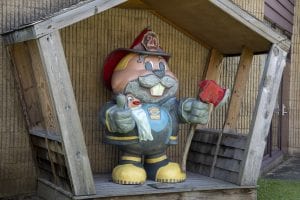
One of the groundhog statues in Punxsutawney, Pennsylvania.
From Pittsburgh, I could launch into Ohio and complete a long Midwest circuit before traveling through Big Sky country, the Pacific Northwest, and eventually the West Coast.
I had to eliminate the two-day stay at West Yellowstone as well as take back a day in Florida that had been added. But those sacrifices made the 60-day trip a do-able drive.
The route was set. Well, for two months anyway.
——————————-
In March 2019, Mary was watching a cooking show featuring Ree Drummond, the “Pioneer Woman” of Oklahoma. A little digging uncovered how important she’s been to the economy of her hometown of Pawhuska. So, a plan was hatched to swing through that community.
The change required an extra day in the Sooner State. The time needed to be made up somewhere. I decided to eliminate my Day 3 travel to the Four Corners Monument that included a stay in nearby Cortez, Colorado. The monument would have been fun to visit, but it doesn’t really have an interesting history or any cultural significance.
So, Day 3 became a straight drive from Flagstaff, Arizona, to Albuquerque, New Mexico. The new route also offered the opportunity to mention the Sky City Native American village, the oldest continuously inhabited settlement in North America.
Along the same lines, the Day 5 visit to Carlsbad Caverns was also scratched. The caves are interesting, but they too are mostly a tourist destination and were adding three hours of driving to that day’s travels.
This streamlining would become common as I continued to hone my 60-day trip.
———————————————–
During spring 2019, I also began tracking the weather along my route on a day-by-day basis.
On March 20, the weather in central and southeastern California was noted. On March 25, the weather in Texas was charted. And so on.
The same process was repeated in spring 2020.
One of the things that stood out during those two springs was how much it still rains in this country in April and May. Not so much in California. But pretty much everywhere else.
The discovery highlighted the need to be flexible. A snowstorm or a deluge could prompt an extra night’s stay in one of the overnight cities on the route. For this reason, I decided to book hotel rooms only five days or so in advance. Easier to alter reservations in a half-dozen towns than to rebook the final 40 days of a trip.
————————————————-
Sometimes, events of cultural significance will force changes.
In October 2019, stories appeared about the 50th anniversary of the 1969 Woodstock music festival.
It became clear somebody from my generation needed to add the New York mountain town to the itinerary. The concert itself was not held in Woodstock. It happened near the small town of Bethel, an hour and a half to the southwest.
So, Day 31 of the trip from Concord, New Hampshire, to Syracuse, New York, was reconfigured to travel from Concord, New Hampshire, to Callicoon, New York, a small town near Bethel that actually has a hotel.
A few days later, I was plotting the journey from Callicoon through Syracuse on the way to Buffalo. That involved seven hours of driving without much time to stop and see the many interesting sites along the way.
That segment needed to be broken up.
As it turns out, Seneca Falls, New York, is not too far from Syracuse and it’s quite an interesting place. There are a lot of sites devoted to women’s history due to an 1848 women’s rights conference held there. It also has a “It’s a Wonderful Life Museum” because Seneca Falls is reportedly the town director Frank Capra used as a model for Bedford Falls in his 1946 film classic.
The change allowed for two 4-hour driving days instead of one 7-hour to 8-hour trek.
Of course, an extra day had to be found. This, after all, is not 61 Days Around the USA. The additional day in St. Louis was sacrificed.
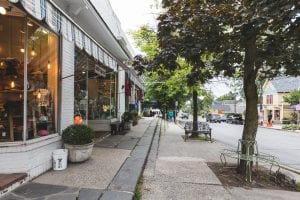
Downtown Woodstock, New York
A few months later, it became apparent I didn’t need to stay in Callicoon. I could actually stay in Woodstock and just add an hour and a half to the next day’s drive to Seneca Falls.
The upstate New York route, once again, had been altered.
————————————-
In December 2019, a story on CBS Sunday Morning brought another reconfiguration.
The segment focused on the orphan train railroad that operated from about 1850 to 1930. The program brought thousands of orphaned and homeless children from the New York City area to farms and small towns in the Midwest to live and work with adopted families.
Some of these journeys had happy endings. Others didn’t.
A little digging revealed that the small town of Concordia, Kansas, has a museum dedicated to the orphan train mission. Seemed like a historical place that needed a visit.
So, the Day 43 route from Kansas City, Missouri, to Omaha, Nebraska, was pushed a bit westward to snare Concordia. To cut down on driving time, the endpoint of that day became Lincoln, Nebraska. Omaha could be passed through the following day on the way to Iowa.
As more locales like Concordia landed on my map, more time needed to be carved out. Eventually, the two-night stays were eliminated in every city except Philadelphia.
——————————————
In January 2020, a tough decision needed to be made.
Green Bay, Wisconsin, was on the itinerary, mainly because it’s the home of the legendary Packers football team.
However, two dairy-related stories had come across my lap. Both were in the center of Wisconsin, not exactly on the way to the shores of Lake Michigan where Green Bay lies.
Green Bay was such a tempting place to visit, but the dairy towns carried more substance and more relevance. So, the meatpacking town of the Packers was checked off the list.
A few days later, another tough call had to be made.
There was a long-standing problem on this section of the trip.
Day 48 required an arduous trek from Minneapolis, Minnesota, to Fargo, North Dakota, to Sioux Falls, South Dakota. An 8-hour drive in all.
The day simply needed to be cut in half. The first half would be Minneapolis to Fargo. The second half from Fargo to Sioux Falls.
On one of my long Sunday hikes, a solution appeared amid the dirt trails and pine trees.
On Day 4, I was scheduled to stay overnight in Roswell, New Mexico, before driving the next day to Las Cruces, New Mexico. Visiting the town known for its UFO sightings was such a temptation. But, like the Four Corners Monument, the town of Roswell was really more tourist than historical.
So, Day 4 became a journey from Albuquerque to Las Cruces via Santa Fe. The day saved was awarded to the Dakotas.
The Dakota split allowed for a trip to the Mall of America south of Minneapolis as well as a visit to one of only two Victory Gardens from World War Two left in the United States.
—————————————–
By mid-March 2020, the COVID-19 pandemic had put my plans in doubt.
There was no way to safely drive across the country while this virus was still on the loose. In addition, if museums, hotels, restaurants, and other sites were still closed, what was the point?
Without a vaccine, it became clear the trip would need to wait another year. Or maybe two.
Still, I forged ahead as if the journey would happen as originally planned. Better to have everything lined up and then be forced to wait until next year as opposed to not being prepared and then having the trip thrust upon you.
So, on March 20, exactly one year before I was scheduled to begin the trek, I had a phone conversation with Kevin McCree, an account executive at Hearst Media Services.
They design web pages, including a lot of newspapers such as the San Francisco Chronicle. I was aware of their reputation and their work. They seemed like the ideal company to build my 60 Days Across the USA website.
It turned out they could do everything I wanted. The $3,000 fee for building the page was affordable. So was the $150 monthly maintenance charge to oversee the site.
A big step forward.
———————————————–
On April 27, a milestone was reached.
I finished my basic research on the 400 places and sites on my itinerary to visit. There were now 275 pages of notes with links to sources of information.
The next day, I began laying out my daily driving schedule. It detailed the time of departure every morning as well as the arrival at every location, what I’m visiting, how long to stay at each place, and when I arrive at that day’s final destination.
The idea was to wake up at 6 a.m. each morning and head out between 7 a.m. and 8 a.m. depending on how much traveling and visiting is required that day. The goal was to see everything along the way and still arrive at that evening’s hotel between 3 p.m. and 4 p.m. before exploring that town.
The detailed planner required some minor adjustments along the route. Driving through some towns instead of stopping. Visiting two sites instead of three in certain cities.
A bit meticulous but a lot of fun. The trip was coming into vision.
————————————————–
In mid-May, I took a deep breath and, with Mary’s permission, signed a contract with Hearst Media Services. I was kind of committed at that point.
A few days later, I was studying the Philadelphia area and saw that a community called Levittown was nearby. Levittown? That’s the name of the neighborhood built on Long Island in 1947 that’s considered the first modern suburb. Could this be another one?
Turns it out it is. This enclave is actually the second Levittown, built in 1952. Quite a story behind it, too. One that includes the building of a self-sustaining community as well as the “redlining” of minority homeowners.
The community is also on a more direct route to the scheduled towns of Princeton and Edison, allowing me to avoid the dreaded New Jersey Turnpike.
——————————————————
It was getting close to the time to put pen to paper.
The research was done and the daily planner was near completion.
The actual prose that would appear on the 60 Days website could soon be written.
So, over the Memorial Day weekend, I began to re-read John Steinbeck’s journal “Travels With Charley” about his 34-state drive around the United States with his beloved French poodle. The goal was inspiration.
The book was finished on May 31. The next day, I pulled out my notes on the planning for this trip and started to compose this piece.
On the same day, Kayta Gentry, the custom website project manager for Hearst Media, sent over the first mock-up of the 60 Days Across the USA.
It was stunning and thrilling. Different than my mind’s eye saw it… and much better than I imagined.
A red, white, and blue color scheme with a Route 66 motif. Clean, artsy layout. Well organized. Easy to follow. It was a beautiful thing after almost two years of research and planning.
I made a few minor modifications and told Kayta’s web team to proceed.
They sent over a working model a couple of weeks later.
—————————————
It was now time to actually begin the process of writing.
This is pure joy for a writer. The research and preparation were finished. Now, you get to sit down and start crafting the words. It’s like starting to paint a house after you’ve done all the prep of scraping, sanding and trimming.
Seven pre-baked stories were needed to take up residence early on the web site to fill slots before the 60-day trip actually begins and the daily journals start to populate the page.
The first column was this one on the origins of 60 Days Across the USA. The initial draft took three days. More would be added in the months and years ahead.
This second article was on the nine states that have panhandles. Yes, it’s more than Florida, Texas and Oklahoma. Interesting stories behind each one.
Stories on the country’s geography, shifting population and most important historical moments would soon follow.
——————————————–
By the second week of June, it had become apparent the protests over the murder of George Floyd at the hands of four Minnesota police officers were going to redefine at least some of what I would be doing on this trip.
There was a sea change sweeping the country. The mistreatment by police of people of color was no longer going to be tolerated. The systematic racism in our country would no longer be ignored or brushed off. People of all races and persuasions were rethinking how they viewed racism and what they could do about it.
I added to my agenda the street corner in southern Minneapolis where George Floyd died.
I firmly committed to visiting the St. Louis suburb of Ferguson where Michael Brown was gunned down by a police officer in 2014.
The museum in Montgomery, Alabama, dedicated to the history of lynching in America was already on my itinerary, but I expanded the focus that would be given to it.
The same for the various locales across the country where I had noted other lynching incidents as well as places of civil rights actions and sites of mistreatment of people of color.
There would be more from this monumental shift in our country’s psyche in the months ahead.
I planned to keep a close watch and alter my journey accordingly.
————————————
The writing of the panhandle column turned out to be more fun than anticipated. It also has turned out to be the most widely read story on the site, thanks in part to the article landing on a Reddit subpage.
In the course of digging up panhandle information, I kept stumbling across oddities in the country’s geography.
There’s the so-called chimney of Pennsylvania that sticks up between New York and Ohio to give that state access to Lake Erie.
There’s a town in Iowa that was separated from the rest of the state when the Missouri River changed course after a flood.
There’s a little sliver of New Mexico that juts into the Oklahoma Panhandle.
There’s a tiny “pimple,” as they call it, of Massachusetts that dips down into Connecticut.
All these geographic quirks have a history and there’s a reason they are where they are.
At first, they were being used as the introduction to the panhandle article, but I soon realized they were an entity unto themselves.
So, a “geographic oddities” column was created.
—————————————
In mid-June, the publicity around President Donald Trump’s planned rally in Tulsa, Oklahoma, spurred another idea.
The 1921 mass murder of black citizens by white residents in a section of town known as Black Wall Street convinced me I need to spend more time on this topic than I had planned to do when I visited Tulsa.
However, concern grew that stories like this could get lost in a daily journal filled with other historic and cultural items from other towns along that day’s route.
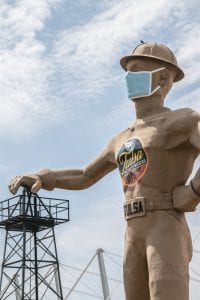
The statue of an oil worker in Tulsa, Oklahoma
So, the idea was born to create three “Spotlight” boxes in the lower portion of the website. A stop on any day’s journal could be expanded into a full-length feature and highlighted in the “Spotlight” section. The story would sit in the prime location in one of the boxes for a few days before the next “Spotlight” story was slotted in.
The Tulsa white riot would definitely be one of those in-depth articles.
—————————————–
In mid-July, I finished the half-dozen columns that would fill the six spots on the website below the main story. They were on United States population, 1800s expansion, state facts, panhandles, rivers and odd geography. The main story would be this blog on the inspiration behind this trip.
Those seven stories would occupy those slots after the website went live and before I began my trip.
This writing was quite fun. I used the notes from my two years of research, so it was like a reward for all that foundation work.
————————————-
In late July, I finished the three pre-trip Spotlight articles for the bottom of the website.
The topics were the history of immigration in the United States, the decline and importance of local newspapers, and the reoccurrence of the discriminatory “Jim Crow” laws and sentiments throughout U.S. history.
I also polished up the first draft of this column on the inspiration for my cross-country journey. This piece continues to be updated. It initially was set in the number one slot on the website, eventually being replaced by the report on the first day of my 60-day expedition.
—————————————–
On August 1, I started writing the preliminary drafts of each of my 60 days on the road.
These columns contained all the material I have gathered. Anything I could write before I hit the road was laid down in these stories. The plan was to have each day’s journal be 90 percent written before I ever departed.
Once on the road, I planned to spice up the stories with what I saw and what I heard along the way.
This phase of my work began almost exactly two years after I initially conjured up the idea of a cross country trip.
It was an exciting juncture. All the research and groundwork was done and I could start putting words onto pages.
This was what I’d been aiming for the entire time.
I set a deadline of March 1 to finish all this pre-journey writing.
After a week of writing, it became clear that I would need to do some interviews to supplement the research material. You need a voice in there to help break up all the dates, statistics and news reports.
So, I started a list of interviews of elected officials, newspaper editors, business owners and others that need to be done both before and during the trip.
——————————————–
As I was writing Day 2 of my journey through northern Arizona, I discovered an 82-mile section of the old Route 66 that is the longest uninterrupted stretch of that famous highway that you can still drive.
The detour added a half-hour to my drive time for this day, but I had to do it. I had to get a feel for what that route was like during its heyday.
There were also some small towns along the roadway that were devastated when Route 66 was replaced by Interstate 40. Gotta be some good stories there.
I also decided I could use some of the issues confronting local communities to discuss the topics in a larger, nationwide manner. So, I added material to my discussion of farmworkers in California’s Central Valley as well as my reports on the cannabis industry in the eastern California town of Needles.
———————————
In late August, the paradigm on this journey changed dramatically.
I took into consideration the idea of basically abandoning my wife, Mary, for two months. She and I brainstormed about the trip that evening. Part of the discussion was the successful “virtual convention” the Democratic Party had pulled off the week before.
The nature of the journey soon became apparent. Information and reality tend to clear things up.
I decided to make the 60-day adventure a quasi-virtual affair. If the COVID-19 situation allows, I would rent a car and drive the first two weeks of the trip. I would then post the remaining six weeks after I flew home from Louisiana as a “virtual journey.”
During the following four years, I could drive about two weeks every spring on the next junctures of the trip to eventually fill out the journey. The website would then be a living document that is constantly updated based on events and news.
Under this scenario, I could publish the website live in early January 2021 and go from there. The expenses were spread out over a number of years. I also could use vacation time from work instead of a sabbatical.
I went to bed that evening with a large weight lifted off my shoulders. This was a trip I could afford and manage in smaller bites.
————————————————-
I finished the first draft of the initial four days of the 60-day journey on September 1.
The writing process had been entertaining and satisfying. All the spadework I did over the previous two years had allowed me to pretty much write freely from my notes.
I still had to update material and double-check things, but for the most part, it was just freewheeling writing, something of a joy for any writer.
I did have to pick up the pace, though, or I wouldn’t meet my March 1 deadline of finishing the first drafts of all 60 days.
—————————————————–
On October 8, I was watching a news report of yet another hurricane bearing down on the Louisiana coast. This time, it was Hurricane Delta, coming to shore less than two months after the devastating Hurricane Laura slammed into southern Louisiana.
I decided I needed to alter my route for Day 12 to visit the hurricane area.
Originally, I was planning to drive from Little Rock, Arkansas, to Baton Rouge, Louisiana. Not a whole lot in between the two, but it gave me a chance to do a short hop the next day to New Orleans, where I could spend all afternoon visiting the multitude of interesting sites there.
The town that seemed to be hit the hardest by these hurricanes was Lake Charles. The drive from Little Rock to there was about the same amount of time as the route to Baton Route, so why not.
This change also required me to alter the beginning of the Day 13 journey.
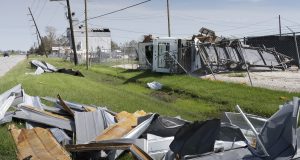
Some of the damage in Lake Charles, Louisiana, from a September 2020 hurricane
I needed to drive from Lake Charles along Interstate 10 to Baton Rouge before heading down to New Orleans. Along the morning route, I could stop in Rayne, Louisiana, which was once considered the “Frog Capital of the World” as well as Lafayette, Louisiana, which is considered the center of Cajun culture in Louisiana.
I’d still cross the Mississippi River before hitting Baton Route and I’d still arrive in New Orleans early in the afternoon.
It added work and slowed up the progress on the writing, but it was a change worth doing.
_____________________________
On December 8, I had a video conference with the Hearst Media folks to learn how to manage and edit the web page.
Fortunately, it was similar to what I use at my job at Healthline and the Hearst folks had set up a simple system.
I went in that afternoon and made some minor changes for practice. It all seemed to work.
A few days later, I spoke on the phone again with Kayta. She answered the handful of questions I had on the site.
We set a launch date of January 4. This was getting real.
—————————————————
A few days before Christmas, I finished the initial writing for Day 22 of the trip. That meant I still had 38 segments to finish before March 20.
That was going to take a lot of hours, so I needed to make the most of the holiday break.
I told myself I will get this done. I didn’t want this writing to be a job. I wanted it to be a joy.
One thing had become crystal clear during my writing the past couple of weeks. The main purpose of all these columns — the 60 days, the Spotlights — was to allow readers from one part of the country to learn about other regions of the nation. If we know more about each other, then maybe we can understand each other more.
The point was hammered home one evening when Mary and I watched the documentary, “The Antidote.” The main message behind that film is that kindness and understanding are cures for a lot of what ails us in this country.
——————————————————–
On January 14, an event 2 years and 5 months in the making finally occurred.
The website for this journey went live.
I had to rub my eyes several times to make sure I really was seeing that this creation I first envisioned in August 2018 had actually come to fruition.
I did notice the website address was 60dayusa.com, not the 60daysusa.com I had intended it to be.
It seems there was a typo on the GoDaddy site application and none of us noticed it.
No matter. People will find the site if they want to read it.
I decided to start publicizing the site after the inauguration of President Joe Biden when things were more settled.
For the moment, I just kept writing. I started Day 29 that day. Still a long way to go to finish those 60 columns.
But I had until March 20 or even beyond to complete the task, so no panic. I wanted to continue to enjoy the process.
——————————————————————————————————-
On January 21, I received a COVID-19 vaccine through a local fire department.
The vaccination left me relieved and grateful to be getting inoculated at the height of the pandemic.
It also meant I’d get a second dose in late February. By mid-March, the vaccine would take full effect.
That made it more possible that I’d be able to drive the first two weeks of this trip, although I did have to wait to see if the number of COVID-19 cases were declining at that point. Even with the vaccine, you can still contract the virus and spread it to others, even if you don’t get sick. So, I wanted to be sure it was safe for me and everyone else before I ventured out.
—————————————————————————————————————-
About a week later, I finally bit the bullet.
It was apparent that the COVID-19 pandemic would not be under control that spring. It might be better, but it still wouldn’t be safe.
So, I decided to do a virtual journey for the entire 60 days in spring 2021 as if I was on the road. It was not only safer, it was also more manageable and easier.
So, that was the plan. Virtual for spring 2021. Then, we hit the road later.
On the final weekend in January, the purpose of this site encountered another shift.
I was paying my two daughters, Melinda and Katherine, a nominal fee to do some marketing for this venture.
They’d been building Twitter and Instagram pages. As they did, we hit upon another approach.
Their suggestion was to make a major component of the site a travel guide for readers.
Their thought was that when COVID-19 eased and it was safe to travel again we could provide a bit of a road map for readers anxious to hit the highways.
The idea was to look at each of the 60 daily columns as segments that readers can piece together to form their own itinerary. It could be a 5-day journey, a 10-day sojourn or a month-long adventure. They could use our route through the Southeast, for example, to plot a path through Florida, Georgia, South Carolina and North Carolina. They could follow our route precisely or venture off it at times to create their own itinerary. They could also stretch 4 days on our agenda to 7 days or even more on their schedule.
A primary purpose of the site would still be to provide people with the history, culture and struggles of all 48 states. However, the travel guide aspect could be used to help people get the most out of their vacation travel as well as help small businesses, museums, tourist attractions and other places rebound from the pandemic lockdowns.
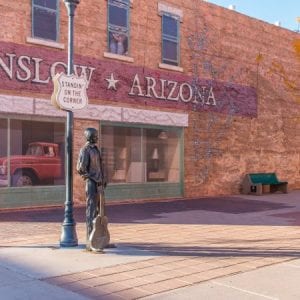
Standing On The Corner Park in downtown Winslow, Arizona
So, I changed the “student center” to the “travel center” and rewrote the “basics of the trip” article.
And off we went.
———————————————————————————
On February 16, another milestone in this journey was reached.
I did my first phone interview for an article on the site.
The conversation was with Bob Hall, the chief executive officer of the Chamber of Commerce in Winslow, Arizona.
It was quite fun to finally converse with someone about some of the material I have been researching for more than 2 1/2 years.
We discussed life in Winslow and places to visit in town, including the Standing’ on The Corner Park there in honor of The Eagles’ 1972 hit “Take It Easy” in which the town is mentioned.
Another interview with a New Mexico community activist was scheduled for the next day and yet another interview with a manufacturing industry advocate two days later.
We were rolling now.
——————————————————————————-
As March unfolded, another half-dozen interviews were in the books.
I also set up a weekly Saturday newsletter through Constant Contact and started to prepare its launch on March 6.
It’s hard to believe that after all this planning that the March 20, 2021 date that had been set more than 2 years ago was less than 3 weeks away.
I continued to write Spotlight features and had just completed the prewrite on Day 37 of the journey.
—————————————————————————————
March 20, 2021 finally arrived.
The Day 1 post from San Francisco to Needles, California, was published.
After 2 1/2 years of planning, this virtual journey had finally begun.
Although I wasn’t driving the route as originally planned, there was a sense of satisfaction and pride in getting this first column on the site.
A lot of work ahead, but the fun had just started.
On May 18, I finished the 60th and final daily column of the virtual journey.
In the months that followed, I kept up a daily routine of updating one column every day, starting at Day 1 and working through Day 60 two months later.
When I finished with Day 60, I started on Day 1 again and began the routine all over.
By the end of the year, I had updated each daily column at least three times.
As 2022 dawned, I began to make plans to actually drive parts of the route every spring as close to the original dates as possible.
At first, I was going to do it in 2-week bits, following the virtual journey almost to the letter. At that pace, it would take me 4 springs to finish the 60 days.
Then, I realized there was no hurry. I could get more out of the journey by spreading it out over the next 8 or 9 or even 10 years.
It also occurred to me I didn’t need to follow the virtual journey exactly as originally planned. I could take 10 days or so each spring, spending a little more time in some of the more interesting places.
So, I charted out a course for the first 7 daily columns through California, Nevada, Arizona, New Mexico and Texas, ending up in San Antonio. I figured I could rent a car for the drive and then deposit it at San Antonio’s airport before flying home.
In February, I received some great news.
Mark Shuman, my close friend from college, informed me he wanted to travel with me for the entire 11 days of this initial trek.
He even offered the use of his car, saving me $1,000 in rental car costs. I told him I’d pick up the hotels if he paid for gas.
His plan was to drop me at San Antonio airport at the end of our trip and then drive back to California via a slightly different route.
Having a traveling companion was going to make this journey even more fun and interesting.
Finally, we’re going to physically hit the road.
Eleven days. Nearly 3,000 miles.
That’s how long Shu and I were on the road.
From March 18 to March 29, we saw just about everything there is to see in the American Southwest.
We got snowed on at the Grand Canyon in Arizona. We walked on the white sands of a national monument in New Mexico. We witnessed a wedding on Marriage Island in Texas.
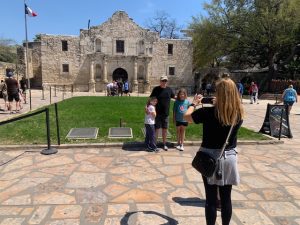
Tourists at The Alamo in San Antonio, Texas
Along the way, we saw the country emerging from a 2-year pandemic and returning to tourist sites, restaurants and stores. Crowds were plentiful everywhere, even in the remote town of Los Alamos in the New Mexico mountains.
We saw the beautiful and the not-so-beautiful. The historically important and the culturally significant. All part of the landscape.
We also felt the impact of the nation’s labor shortage. In every town, there were hotels, restaurants, museums and coffee shops that were short staffed, resulting in long lines. The people working at these locales were good at their jobs. There just wasn’t enough of them.
We also noticed the burgeoning infrastructure repair programs now under way. Throughout our route, there were highways and streets being rebuilt, buildings being remodeled and new buildings rising from the ground.
I learned a lot while chronicling this adventure. Among the lessons was to keep driving time to less than 5 hours per day and to be selective in how many places we stopped and how many people I interviewed.
Shu and I hit the road again in late March 2023. The 10-day sojourn lasted until early April.
We began the trek in San Antonio, where we ended the 2022 journey.
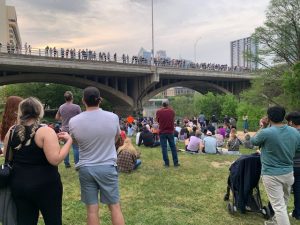
People gather to watch the nightly flight of bats from under the Congress Avenue bridge in Austin, Texas
Our first stop was Austin, Texas, where we traveled to The Oasis, the largest restaurant in Texas as well as the Lyndon Johnson presidential library and the Congress Avenue bridge, where more than 1 million bats make their nightly pilgrimage every evening in search of food. Their departure from underneath the bridge took more than 30 minutes to complete.
From there we went to Dallas, where we visited the spot where President John Kennedy was assassinated. We then visited Fort Worth, Texas, Oklahoma City, Tulsa and Little Rock.
Looming thunderstorms forced us to skip the Lake Charles portion of our Louisiana travels, so we headed directly to New Orleans, where we spent a couple days visiting Bourbon Street in the French Quarter as well as Mardi Gras World and the city’s Garden District.
In July 2023, my wife, Mary, and her sister, Marcia, joined me on a tour of New England.
We flew into JFK Airport in New York, then drove the length of Long Island to the beach town on Montauk. We spent another day exploring the shops, homes and restaurants in the Hamptons.
Our traveling trio then drove back across Long Island, through New Rochelle and onto Greenwich, Connecticut, picking up the end of our Day 26 route. We visited the Walk of Fame in New Rochelle before having a late lunch at Walter’s Hot Dogs in Mamaroneck, New York.
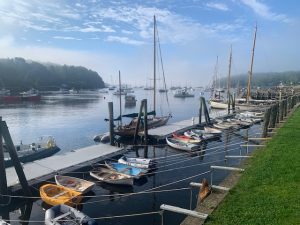
The harbor in Rockport, Maine
From there we drove through Connecticut along our Day 27 route, stopping in New Haven for hamburgers at Louis’ Lunch and walking the hallowed grounds of Yale University. We continued on, picking up the Day 28 route through Massachusetts. We stopped in Concord to take in the beauty of Walden Pond and examine the Orchard House, where Louisa May Alcott wrote her classic book, “Little Women.”
We stayed overnight in Salem and then ventured out toward Maine. Along the way, we stopped by the Rebecca Nurse Homestead near Salem to pay our respects to my great aunts, Rebecca Nurse and Mary Easty, who were executed by religious zealots during the witch hysteria in 1692.
From there we zipped through the small coastline of New Hampshire and picked up our Day 29 route along the coast of Maine. We shopped for an hour at the L.L. Bean flagship store in Freeport before settling in for a couple days in the beautiful coastal town of Rockport. While we there we made the pilgrimage to Erin French’s “Lost Kitchen” restaurant in the small rural town of Freedom.
After that, we went off course for the rest of our trip, traveling to Bar Harbor and getting a tour of Acadia National Park before driving back to Massachusetts for a couple days on Cape Cod.
Quite a trip with a good mix of 60 Days sites as well as some simple travel off the website itinerary.
In fall 2023, I set another goal for my travels that will cause some adjustments to my future trips.
In August, Mary and I had joined our good friends, Tom and Sue Keane, at their beautiful beach home in Malibu in Southern California. As part of our stay, we went to the Ronald Reagan presidential library. I love presidential libraries and realized I had already been to five of them. In addition to Reagan’s library, I had visited the John F. Kennedy library in Boston in the 1990s and taken my mom to the Harry Truman library in Missouri in 2022, and stopped in at the Lyndon Johnson library in Austin, Texas, and the Bill Clinton library in Little Rock, Arkansas during the spring 2023 road trip.
I did some research and discovered there are 13 official presidential libraries overseen by the National Archives. President Barack Obama’s library will be the 14th. I decided I wanted to see them all.
The first step was a 3-day weekend trip to Los Angeles in November 2023, where Shu and I visited the Richard Nixon Presidential Library. That was my 6th such library.
Shu and I are driving from New Orleans to Atlanta in spring 2024. We’ll stop by the Jimmy Carter library in the Georgia capital for library number seven.
By adding an extra day to some of the future road trips, we can also visit the Herbert Hoover library in Iowa, the Franklin Roosevelt library in New York, the Dwight Eisenhower library in Kansas, the Gerald Ford library in Michigan and the Obama library when it is finished in Illinois.
The libraries for presidents George W. Bush and George H.W. Bush will require an extra separate journey back to Texas.
All in due time.
David Mills
60 Days USA

